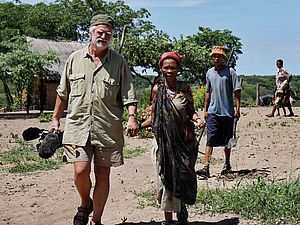
The history of the Bushmen is the tragic story of one of the world’s oldest peoples who populated southern Africa up until the day other races, black and white, took over their land and finally crushed them altogether. Their history is identical to that of the American Indians. But while the conquest of the American Far West has been the subject of countless works and films, the history of the South African trekkers is less well-known.
The Bushmen were the first inhabitants of Southern Africa. When the first Bantou runaways, driven away from slavery, came down from the north, starving and frightened, the Bushmen gave them refuge. For their tradition has always been generosity. But, almost without exception, these wanderers from the north, once helped, banded together with others to exterminate the Bushmen and take over their pastures.
The humane generosity of the humble hunter was betrayed by the inhumanity of those he had helped. The invaders never considered, that as the prior occupant, the hunter should be attributed certain basic rights.
The Dutch Europeans considered themselves superior to all the other natives, basing their superiority, above all, on biological criteria. The short stature, the skin colour and the fat developed buttocks of the Bushmen were denigrated as being characteristics belonging to the inferior branches of the human race. On their horses, the settlers killed the Bushmen, their left hand on the Bible, their right on their guns.
As a people the Bushmen do not exist. At first, this designation was nothing more than an insult. All the ethnic peoples from the bush were named thus : wild , elusive, not assimilable and therefore dangerous. At first, there were the GWIS, the GHANAS, the KUNGS, the NHAROS and many others. The term Bushmen became fixed at the end of the 19th century, indicating a people of hunter-gatherers, wise savages, as Rousseau would say.
In the 1960s, scientists, considering the term too negative, replaced it with SAN, a term from the Nama language. However, it was no better since it translated as vagabond or brigand. The unattractive French ‘Bochiman’ fell into disuse and the term Bushman is used today without any judgement of value.
All these ethnic groups have been decimated. The survivors have regrouped, mixed together at the expense of the uniforming of identities, languages and practices . Only one ethnic group has been able to distinguished from all the others by its genetic material. This is a separate, ancient lineage : the JU’HOAN which was, from then on, to be the oldest people in the world. It was with the JU’HOANS that I spent 4 years and who are the protagonists of my film. They still live much as their ancestors did.
They sow no grain, breed no animals. They are among the rare inhabitants of our planet who subsist on hunting and gathering. They are hunter-gatherers. But the term hunter-collectors seems to me more appropriate since what they collect, not only includes root and plant extracts, fruits or leaves, but also other products like insects, chrysalises, reptiles, honey and eggs.
They are a primary people. I no longer dare to employ the word primitive which was used to describe groups who were rooted in the prehistoric past, for little by little, its meaning which was not at all pejorative, has changed and now suggests poor intelligence, coarse behaviour and savage impulses.
None of these terms are suitable for describing the Bushmen. The idea of primitivism, however, plays against them, especially in Botswana where the government regards them as a great burden, even a shame to the nation.
This pejorative conception of traditional peoples is very widespread in the world, particularly in South America and Asia.
When a culture is destroyed in the name of progress, there is no progress, only loss to all of humanity.
I believe that a country which is privileged to have such people on its land, should not ignore or deny the wealth they have to offer it
The Namibian government has understood this well and it respects all the ethnic groups on its territory. The Bushmen fulfil their natural needs in a few hours of daily work, the rest of the time being given up to social and family relations and rituals.
In more ways than one, their ethics are enviable. Each person has his place within the tribe, nobody tries to dominate over the others, only collective interests count. Non-violence is a value which is never transgressed. Another important value is hospitality, as our film crew became aware during our numerous visits over the 4 years of filming.
They educated their children, for example, from mythical stories and task learning.
While they have no knowledge of writing, the oral tradition is transmitted to collective memory. The Bushmen have a sense of humour and a cheerful nature and they will gently mock each other. Death is the men’s department. Life, through feeding reproducing, is the women’s. The south wind which breaks up the clouds and burns the grass is the male wind because it kills. The north wind which brings rain is female. Electric thunderstorms bring male rain whereas gentle, regular rain is female rain.
And when death comes, the life-bearing women are shrouded, looking east where the day begins. The men look west where the sun disappears.
The Bushman’s language must be the most difficult in the world. Since the fiction film “The Gods must be crazy”, everybody knows that the Bushman clicks his tongue in his language. In fact, there are five clicks. It is not only difficult because of the 5 clicks but also because, to make plurals, they repeat words which produce 3 different tones to each word and which convey 3 totally different meanings.
There are over 60 000 rock paintings and engravings throughout Southern Africa. Some are 20 000 years old. For the paintings, the shamans use the blood of a freshly killed eland and mix it with the paint. The eland is the most powerful African antelope. The animal’s blood contains its strength and consequently the pictures painted on the rock become reservoirs of strength. When the shanons feel their strength decline in dancing, they turn to the pictures of the eland, impregnated with blood and the power from the paintings takes hold of them and projects them into the spiritual world.
We do not know if the paintings and engravings were meant to be chronicles depicting the life of the group, if they had an educational role or if they were a means of communicating between earthly life and the spiritual world, a sort of medium for religious beliefs. It is not impossible, since these beliefs are deeply rooted in the Bushmen. They have permanent contact with the spiritual world. There is no clearly defined god, but an unshakeable faith in the existence of a supreme being who creates and dominates.
Ancestral spirits are also important elements in the group. They believe in their protective force, their care, but also their anger when there is transgression of the rules or customs.
As the weeks and my successive visits went by, I was able to gain the Bushmen’s confidence.
With the crew, we were welcomed as friends, not as picture thieves.
I was anxious to adhere to film maker Jean Rouch’s ethnic documentary approach which is based on total respect of those being filmed.
No pictures were taken without them knowing.
All artificial representation of reality was ruled out.
I would like to pay tribute to this people who has taught me what true humanity is, a people for whom I feel a deep love.
To preserve primary peoples in the modern world, to promote knowledge of cultures different from our own, is not a utopia. To respect these ethnic groups and their way of life is a sign of civic spirit, of progress and tolerance.
Persecution undergone by native peoples, hides greediness and racism which relegates them to an inferior status.

